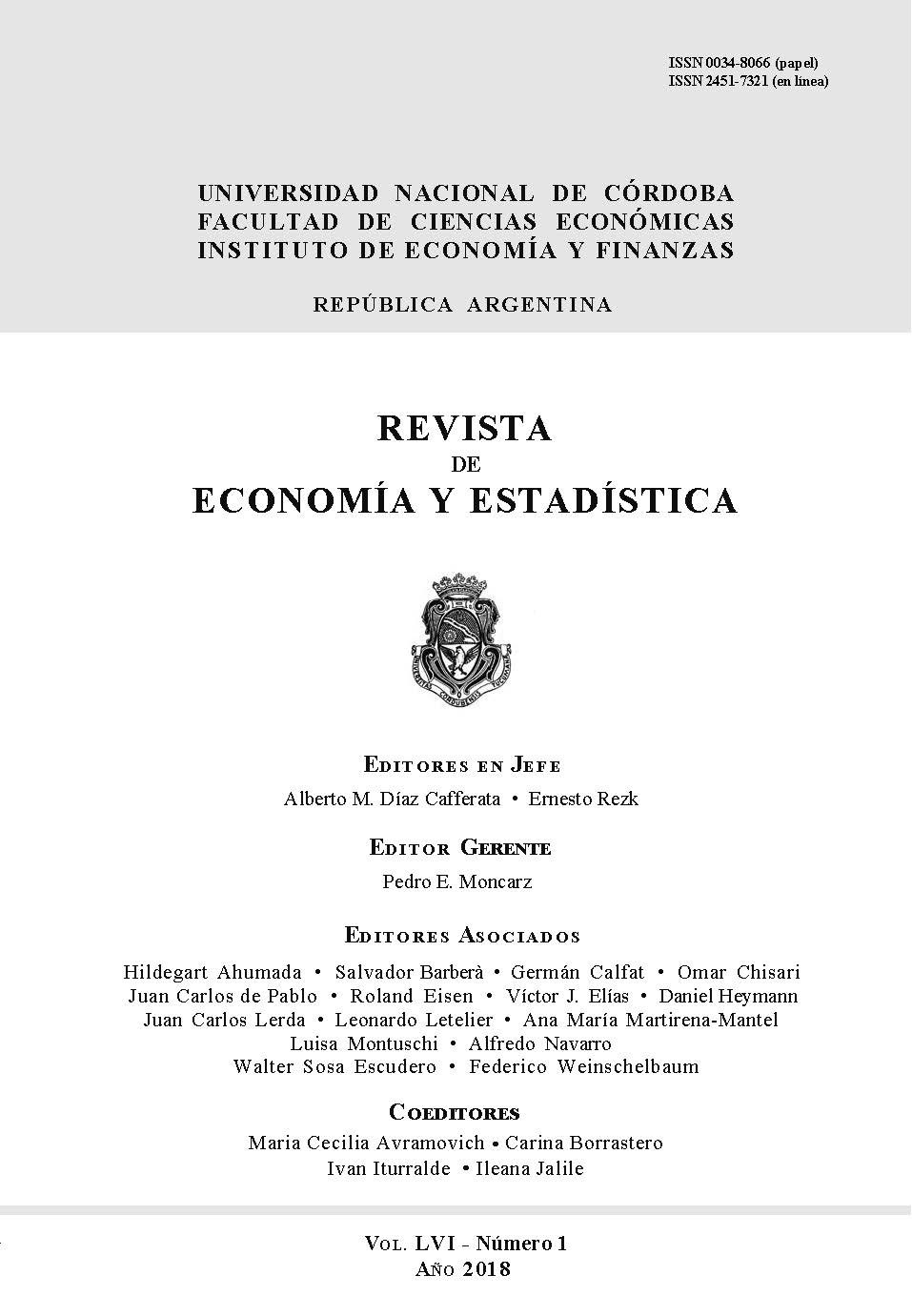The EU real exchange rates: A structural Bayesian VAR. A note.
DOI:
https://doi.org/10.55444/2451.7321.2018.v56.n1.29387Keywords:
competitiveness, european integration, bayesian estimation, real exchange ratesAbstract
In this paper we contribute to the long literature on the real exchange determination by estimating a Bayesian structural vector autoregressive model. We aim at identifying the effect on the EU-28 RER of shock originating in its main fundamental variables, namely, current account, government consumptions, investment and real income. We find in most of the shocks that the RER moves away for long periods, proving yet again, that the purchasing power parity condition is rarely fulfilled empirically.
Downloads
References
Amano, R. A., and S. van Norden. (1995). ‘‘Terms of Trade and Real Exchange Rates: The Canadian Evidence’’. Journal of International Money and Finance 14(1): 83–104.
Amano, R. and S. van Norden. (1998). ‘‘Oil Prices and the Rise and Fall of the US Real Exchange Rate’’. Journal of International Money and Finance 17(2): 299–316.
Benigno, Gianluca, and C. Thoenissen. (2003). ‘‘Equilibrium Exchange Rates and Supply-Side Performance’. The Economic Journal 113(486): C103–24.
Berg, A., and Y. Miao. (2010). ‘‘The Real Exchange Rate and Growth Revisited: The Washington Consensus Strikes Back?’’ IMF Working Papers WP/10/58.
Comunale, M.. (2017). ‘‘Dutch Disease, Real Effective Exchange Rate Misalignments and Their Effect on GDP Growth in EU’’. Journal of International Money and Finance 73: 350–70.
Cuestas, J. C. (2009). ‘‘Purchasing Power Parity in Central and Eastern European Countries: An Analysis of Unit Roots and Nonlinearities’’. Applied Economics Letters 16(1): 87–94.
Cuestas, J. C., Gil-Alana L. A. , and K. Staehr. (2014). ‘‘Government Debt Dynamics and the Global Financial Crisis: Has Anything Changed in the EA12?’’ Economics Letters 124(1): 64–66.
Cunado, J. (2011). ‘‘Structural Breaks and Real Convergence in OPEC Countries’’. Journal of Applied Economics 14(1): 101-117.
Frenkel, J.A, and A. Razin. (1996). Fiscal Policies and Growth in the World Economy, Third Edition. The MIT Press.
Gil-Alana, L. A., N. Luqui, and J. Cunado. (2008). ‘‘Trade Balance and Exchange Rate: Unit Roots, Co-Integration and Long Memory in the US and the UK’’. Economic Notes 37(1): 59–74.
Litterman, R.(1986). ‘‘Forecasting with Bayesian Vector Autoregressions: Five Years of Experience’’. Journal of Business & Economic Statistics 4(1): 25–38.
Neary, P. (1988). ‘‘Determinants of the Equilibrium Real Exchange Rate’’. The American Economic Review 78(1): 210–15.
Obstfeld, M., and K. Rogoff. (1995). ‘‘Exchange Rate Dynamics Redux’’. Journal of Political Economy 103(3): 624–60.
Pesaran, H., and Y. Shin. (1998). ‘‘Generalized Impulse Response Analysis in Linear Multivariate Models’’. Economics Letters 58(1): 17–29.
Sims, C. A. (1988). ‘‘Bayesian Skepticism on Unit Root Econometrics’’. Journal of Economic Dynamics and Control 12(2–3): 463–74.
Taylor, A. M. (2002). ‘‘A Century of Current Account Dynamics’’. Journal of International Money and Finance 21(6): 725–48.
Vieira F., and R. MacDonald. (2012). ‘‘A Panel Data Investigation of Real Exchange Rate Misalignment and Growth’’. Estudos Econômicos, 42(3): 433–56.
Wei, S. and D. Parsley. (1995). ‘‘Purchasing Power Disparity During the Floating Rate Period: Exchange Rate Volatility, Trade Barriers and Other Culprits’’. National Bureau of Economic Research. Working Paper w5032.
Downloads
Published
Issue
Section
License
Copyright (c) 2018 Juan Carlos Cuestas

This work is licensed under a Creative Commons Attribution-NonCommercial-NoDerivatives 4.0 International License.
Authors who have publications with this journal agree to the following terms:
Authors retain their copyright and grant the journal the right of first publication of their work, which is simultaneously subject to the Creative Commons Attribution-NonCommercial-NoDerivatives 4.0 International License that allows third parties to share the work provided that its author and first publication in this journal are indicated.
Authors may adopt other non-exclusive licensing arrangements for distribution of the published version of the work (e.g. depositing it in an institutional telematic archive or publishing it in a monographic volume) as long as the initial publication in this journal is indicated.
Authors are allowed and encouraged to disseminate their work via the Internet (e.g. in institutional telematic archives or on their website) before and during the submission process, which can lead to interesting exchanges and increase citations of the published work. (See The Open Access Effect)










